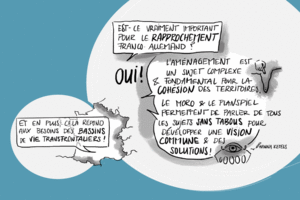News
How can simulation games help spatial planning in a border area?
September 2023
In border areas, living and employment areas are closely intertwined. Differences between planning tools and the organisation of the relevant authorities can hamper integrated regional development. These issues were at the heart of "MORO," a Franco-German spatial planning pilot project. In order to report on the results of this project, the ANCT and the MOT are organising a webinar on 1 December entitled "How to move forward with spatial planning in border areas".
Thanks to experimental formats such as simulation games, the authorities in charge of planning in municipalities and regions can overcome these obstacles and strengthen cooperation between administrations. This is the result of a spatial planning pilot project, known in German as MORO . It involved experimenting with the innovative method of "concertation-action" and simulation games (Planspiel in German) on two pilot sites: the Saar-Moselle Eurodistrict and the Upper Rhine region (Baden-Württemberg, Grand Est region), with the aim of developing integrated planning solutions for these areas.
Work on the SaarMoselle Eurodistrict has laid the foundations for a cross-border conurbation project. For their part, the participants in the Upper Rhine defined the conditions for creating a cross-border multisite business park by initiating discussions in favour of a common economic land policy.
What are the realities and needs in other border areas?
Three round tables will be used to share the results and discuss the recommendations:
- What kind of observation and what kind of data are needed to develop a shared understanding of the region?
- What kind of governance is needed to develop common roadmaps and strategies for border areas?
- What kind of coordination of territorial planning in cross-border areas is needed for the benefit of territorial cohesion?
The webinar, open to all, will be held on Friday December 1st, from 9.30 a.m. to 12.30 p.m. online (zoom).
To register: click here.
The final report can be consulted on the ANCT website, and summary sheets can be found on the “Europe s'engage in France” website and in German on the BBSR website.
1. On the French side, the project was piloted by the Agence nationale de la cohésion de territoires (ANCT), the Prefecture of the Grand Est region and the Grand Est region. On the German side, the Federal Ministry of Housing, Spatial Planning and Building (BMWSB), the German Federal Institute for Building, Urban and Regional Research (BBSR) and the Saarbrücken Urban Community (Regionalverband Saarbrücken) were responsible for the project. The project was carried out jointly by the French urban planning agencies ADEUS and AGURAM, in association with the agl consultancy in Germany.
Photo: ANCT ; all rights reserved.
Back to list
